Description and Technical Data of Hydropneumatic Speargun.
Operating Principle of Hydropneumatic Speargun.
Technical Service of Hydropneumatic Speargun.
Spearshafts and Speartips.
Handgrip Position of Hydropneumatic Speargun.
Description and Photoalbum of Spearfishing Equipment.
Links.
Ukrainian
![]()
Testing of Speargun Performance using different mass, diameter spear shafts and shooting line drag.
As all experienced spearfishermen know, the ability to capture fish is dependent on speed, accuracy and penetrating power of their spear when it strikes the desired target. The speartip and shaft must penetrate the fish's body structure in order to secure a hold or disable the fish, preferably both at once if a vital spot is hit. The primary function of the speargun as the launching device is to direct the spear shaft on the desired course with sufficient energy to achieve this result, however many factors affect the final outcome which is hopefully to secure the fish. The purpose of the experiments described below is to quantitatively assess the effect of varying spear mass on the degree of penetration achieved into a target and the effect of shooting line drag on this performance.
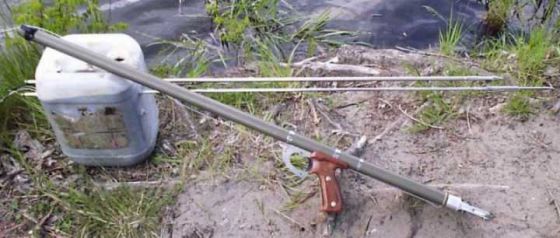 The speargun used was a new derivative of the Aquatech hydropneumatic speargun, the "Black Sea", which is fitted with an auxiliary small bore, lever operated hydropump. This feature enables loading of the gun underwater to internal pressures far greater than could ever be achieved by manually pushing down on the spear shaft with a loading bar. Using the auxiliary hydropump avoids the problem of bending the spear shaft under the strain of muzzle loading, always a possibility with pneumatic spearguns operating at elevated chamber pressures up to and beyond 40 atmospheres. Pumping with a small bore pump reduces the force required of the operator even though the final pressure achieved is high. Even at very high pressure levels the "Black Sea" speargun's hydraulic trigger system easily releases the pent up water column which drives the shaft from the gun, resulting in very high energy output to the spear. This aspect enables big fish to be targeted with greater chance of success at longer shooting ranges.
The speargun used was a new derivative of the Aquatech hydropneumatic speargun, the "Black Sea", which is fitted with an auxiliary small bore, lever operated hydropump. This feature enables loading of the gun underwater to internal pressures far greater than could ever be achieved by manually pushing down on the spear shaft with a loading bar. Using the auxiliary hydropump avoids the problem of bending the spear shaft under the strain of muzzle loading, always a possibility with pneumatic spearguns operating at elevated chamber pressures up to and beyond 40 atmospheres. Pumping with a small bore pump reduces the force required of the operator even though the final pressure achieved is high. Even at very high pressure levels the "Black Sea" speargun's hydraulic trigger system easily releases the pent up water column which drives the shaft from the gun, resulting in very high energy output to the spear. This aspect enables big fish to be targeted with greater chance of success at longer shooting ranges.
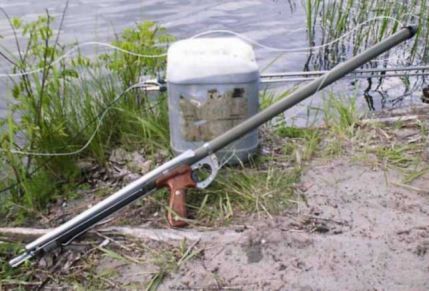 Experiments were carried out in a nearby river with shots taken at a distance of 3 metres from the underwater target. To simulate a fish's body a large plastic container was filled with sand and sunk to the river bottom. Various speargun configurations were tested at a depth of 0.5 metres shooting into the target and measuring the resultant penetration of the shafts. In some instances the shaft completely penetrated and flew right through the single container. A second sand filled container was then placed back to back with a similar container to increase the resistance of the target and better differentiate the shooting performance.
Experiments were carried out in a nearby river with shots taken at a distance of 3 metres from the underwater target. To simulate a fish's body a large plastic container was filled with sand and sunk to the river bottom. Various speargun configurations were tested at a depth of 0.5 metres shooting into the target and measuring the resultant penetration of the shafts. In some instances the shaft completely penetrated and flew right through the single container. A second sand filled container was then placed back to back with a similar container to increase the resistance of the target and better differentiate the shooting performance.
 The initial target was a 10 litre, 14 cm wide, plastic container filled with sand. The spear had to penetrate the sand and both wall thicknesses of the container which were 3 mm. thick. Shooting distance was 3 metres from the target. Penetration was measured by assessing how far the spear projected out the other side of the container.
The initial target was a 10 litre, 14 cm wide, plastic container filled with sand. The spear had to penetrate the sand and both wall thicknesses of the container which were 3 mm. thick. Shooting distance was 3 metres from the target. Penetration was measured by assessing how far the spear projected out the other side of the container.
 To assess the effect of changing spear mass the "Black Sea" speargun was used with the following size shafts. This speargun had a tubular barrel with a 1 metre long spear propulsion stroke and a bore size of 9 mm. Note that the tail fitting on the spears which carries the barrel sealing "O" ring enables the same diameter barrel to be used even though the spear shafts themselves are of different diameters.
To assess the effect of changing spear mass the "Black Sea" speargun was used with the following size shafts. This speargun had a tubular barrel with a 1 metre long spear propulsion stroke and a bore size of 9 mm. Note that the tail fitting on the spears which carries the barrel sealing "O" ring enables the same diameter barrel to be used even though the spear shafts themselves are of different diameters.
Penetration of "light" 6.5 mm diameter tahitiane shaft was 53 cm. (330 gram, shaft fitted with sliding guide, length 120 cm, initial speed 48.7 m/s, initial energy 386 Joules)
Penetration of "medium" 8 mm diameter shaft was 119 cm. (440 gram, shaft fitted with sliding guide, length 113 cm, initial speed 45.1 m/s, initial energy 423 Joules)
At a sufficient initial spear speed it is better to use a spear with large weight.
Penetration of "heavy" 9 mm diameter shaft was 104 cm. (550 gram, length 113 cm, initial speed 40.0 m/s, initial energy 430 Joules)
 As the shafts had easily penetrated through the single container it was decided to increase the thickness of the target by using two plastic containers. The new target was thus made up of two 5 litre, 12 cm. wide plastic containers placed back to back and filled with sand. The container wall thickness was this time 1 mm, but the spear now had to penetrate through four walls as well as the sand inside them. Shooting distance was again 3 meters.
As the shafts had easily penetrated through the single container it was decided to increase the thickness of the target by using two plastic containers. The new target was thus made up of two 5 litre, 12 cm. wide plastic containers placed back to back and filled with sand. The container wall thickness was this time 1 mm, but the spear now had to penetrate through four walls as well as the sand inside them. Shooting distance was again 3 meters.
 Penetration of 7 mm tahitiane shaft was 136 cm. (430 gram, length 140 cm, initial speed 44.7 m/s, initial energy 418 Joules)
Penetration of 7 mm tahitiane shaft was 136 cm. (430 gram, length 140 cm, initial speed 44.7 m/s, initial energy 418 Joules)
Penetration of 8 mm shaft was 118 cm. (440 gram, length 113 cm, initial speed 45.1 m/s, initial energy 423 Joules)
At identical weight of spears, it is better to use spears with a smaller diameter but longer.
Penetration of 9 mm shaft was 59 cm. (550 gram, length 113 cm, initial speed 40.0 m/s, initial energy 430 Joules)
It will be noticed that the 9 mm shaft has the worst penetration. The heavier shaft needs more energy to propel it, so it was decided to elevate the driving force by increasing the bore of the barrel which then increases the cross section that the internal gun pressure acts upon, thereby raising the propulsion force for a given pressure in the barrel.
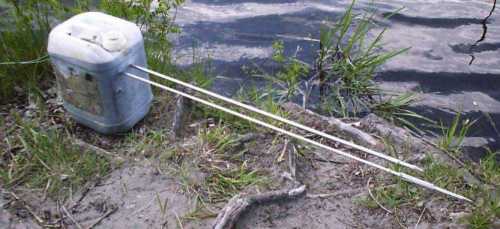 Using a "Black Sea" speargun equipped with a larger 10 mm bore barrel and for the same two-container target as before, at a shooting distance of 3 metres, the following result was obtained.
Using a "Black Sea" speargun equipped with a larger 10 mm bore barrel and for the same two-container target as before, at a shooting distance of 3 metres, the following result was obtained.
Penetration of 9 mm shaft was 113 cm. (550 gram, shaft fitted with sliding guide, length 113 cm, initial speed 45.0 m/s, initial energy 544 Joules)
I then tested the difference between a 2 mm woven nylon and a 1.5 mm monofilament shooting line. The initial target was a 10 litre, 23 cm wide, plastic container filled with sand. The spear had to penetrate the sand and both wall thicknesses of the container which were 2 mm thick. Shooting distance was 3 metres from the target, the following result was obtained.
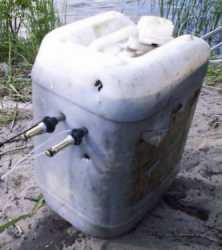 Penetration of 9 mm shaft with 2 mm nylon line was 105 cm. (550 gram, shaft fitted with sliding guide, length 113 cm, initial speed 45.0 m/s, initial energy 544 Joules)
Penetration of 9 mm shaft with 2 mm nylon line was 105 cm. (550 gram, shaft fitted with sliding guide, length 113 cm, initial speed 45.0 m/s, initial energy 544 Joules)
Penetration of 9 mm shaft with 1.5 mm monofilament line had punched completely through container, flown by another 85 cm under water and then plunged into sandy riverbank for 60 cm. (550 gram, shaft fitted with sliding guide, length 113 cm, initial speed 45.0 m/s, initial energy 544 Joules)
Penetration of "light" 6.5 mm diameter tahitiane shaft with 1.5 mm monofilament line was 115 cm. (330 gram, shaft fitted with sliding guide, length 120 cm, initial speed 48.7 m/s, initial energy 386 Joules)
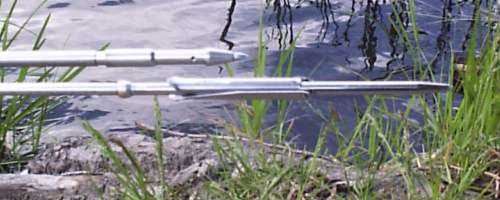 The results of these tests show that spear penetration increases with spear mass provided sufficient launch energy is imparted to the spear. Shooting at long distances requires sufficient gun power to achieve the speed necessary to intercept the target and provide enough energy to penetrate its body structure at the desired location. Shooting line drag detracts from this performance, however smooth surface line has shown to have less resistance than woven line of similar weight and diameter. This result supports the current practice of using high strength monofilament lines in Bluewater hunting, provided no sharp obstructions are encountered by the line.
The results of these tests show that spear penetration increases with spear mass provided sufficient launch energy is imparted to the spear. Shooting at long distances requires sufficient gun power to achieve the speed necessary to intercept the target and provide enough energy to penetrate its body structure at the desired location. Shooting line drag detracts from this performance, however smooth surface line has shown to have less resistance than woven line of similar weight and diameter. This result supports the current practice of using high strength monofilament lines in Bluewater hunting, provided no sharp obstructions are encountered by the line.
Sergiy Kravchenko (June 2004)
This article has been published in magazine "International Freediving and Spearfishing News" (№ 39, Oct/Dec 2004). www.diving-action.com